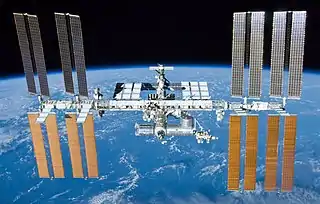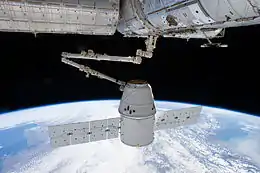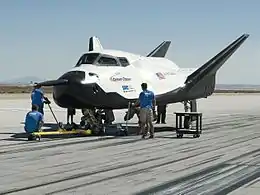Commercial Resupply Services
Commercial Resupply Services (CRS) are a series of flights awarded by NASA for the delivery of cargo and supplies to the International Space Station (ISS) on commercially operated spacecraft.[1] The first CRS contracts were signed in 2008 and awarded $1.6 billion to SpaceX for twelve cargo Dragon and $1.9 billion to Orbital Sciences[note 1] for eight Cygnus flights, covering deliveries to 2016. The Falcon 9 and Antares rockets were also developed under the CRS program to deliver cargo spacecraft to the ISS.


.jpg.webp)
| Part of a series on |
| Private spaceflight |
|---|
| Active companies |
| Active vehicles |
| Contracts and programs |
|
|
The first operational resupply missions were flown by SpaceX in 2012 (SpaceX CRS-1)[2] and Orbital Sciences in 2014 (Cygnus CRS Orb-1).[3]
A second phase of contracts (known as CRS-2) was solicited in 2014. In 2015, NASA extended CRS-1 to twenty flights for SpaceX and ten flights for Orbital ATK[note 1].[4][5] CRS-2 contracts were awarded in January 2016 to Orbital ATK[note 1] Cygnus, Sierra Nevada Corporation Dream Chaser, and SpaceX Dragon 2, for cargo transport flights beginning in 2019 and expected to last through 2024.
Phase 1 contract awards and demonstration flights
NASA has been directed to pursue commercial spaceflight options since at least 1984, with the Commercial Space Launch Act of 1984 and Launch Services Purchase Act of 1990. By the 2000s funding was authorized for the Commercial Orbital Transportation Services program, followed by the Commercial Crew Development program.
On 23 December 2008, NASA announced the initial awarding of cargo contracts - twelve flights to SpaceX and eight flights to Orbital Sciences Corporation.[6] PlanetSpace, which was not selected, submitted a protest to the Government Accountability Office.[7] On 22 April 2009, the GAO publicly released its decision to deny the protest, allowing the program to continue.[8]
The Antares and Falcon 9 launch vehicles and Cygnus and Dragon cargo spacecraft were developed using Space Act Agreements under NASA's Commercial Orbital Transportation Services (COTS) program.[9]
The first flight contracted by NASA, COTS Demo Flight 1, took place on 8 December 2010, demonstrating a Dragon capsule's ability to remain in orbit, receive and respond to ground commands, and communicate with NASA's Tracking and Data Relay Satellite System. On 15 August 2011, SpaceX announced that NASA had combined the objectives of the COTS Demo Flight 2 and following Flight 3 into a single mission.[10][11] The rescoped COTS Demo Flight 2 successfully launched on 22 May 2012, delivering cargo to the ISS. The spacecraft reentered on 31 May, landed in the Pacific Ocean, and was recovered, completed CRS certification requirements.[12][13]
Orbital Sciences first launched the Antares rocket from the Mid-Atlantic Regional Spaceport on 21 April 2013 with a test payload.[14] Orbital Sciences completed the Cygnus Orb-D1 demonstration flight on 29 September 2013, and the operational Cygnus CRS Orb-1 was launched 9 January 2014.[15][16][17][18]
Commercial Resupply Services phase 1
Transport flights began under Commercial Resupply Services phase 1 (CRS-1) in 2012:
Cargo Dragon flights
.jpg.webp)
- SpaceX CRS-1: 8 October 2012[2][19]
- SpaceX CRS-2: 1 March 2013[20]
- SpaceX CRS-3: 18 April 2014[21]
- SpaceX CRS-4: 21 September 2014.[22] The capsule was subsequently reused.[23]
- SpaceX CRS-5: 10 January 2015[24]
- SpaceX CRS-6: 14 April 2015 at 20:10:41 UTC
- SpaceX CRS-7: attempted on 28 June 2015. Launch failure, IDA-1 destroyed.
- SpaceX CRS-8: 8 April 2016
- SpaceX CRS-9: 18 July 2016
- SpaceX CRS-10: 19 February 2017
- SpaceX CRS-11: 3 June 2017 re-flew the CRS-4 capsule and was the 100th launch from LC-39A. The 2,708 kilograms[23] of cargo included NICER.[25]
- SpaceX CRS-12: 14 August 2017. First 'Block 4' Falcon 9, 2,349 kg (5,179 lb) pressurized mass, 961 kg (2,119 lb) unpressurized (CREAM cosmic-ray detector). Last flight of a newly built Dragon capsule.[26]
- SpaceX CRS-13: 15 December 2017[27]
- SpaceX CRS-14: 2 April 2018
- SpaceX CRS-15: 29 June 2018[28]
- SpaceX CRS-16: 5 December 2018[29][30][31]
- SpaceX CRS-17: 4 May 2019
- SpaceX CRS-18: 25 July 2019
- SpaceX CRS-19: 5 December 2019
- SpaceX CRS-20: 7 March 2020
Cygnus phase 1 flights

.jpg.webp)
- Cygnus CRS Orb-1[note 2]: 9 January 2014
- Cygnus CRS Orb-2: 13 July 2014
- Cygnus CRS Orb-3: 28 October 2014 - launch failure, food and care packages for the crew, parts, experiments, and the Arkyd-3 Flight Test (Non-optical) Satellite from Planetary Resources lost.
Following the failure, the Antares 230 system was upgraded with newly built RD-181 first-stage engines to provide greater payload performance and increased reliability.[32] The next two spacecraft were launched on the Atlas V, with the switch to more powerful launch vehicles and the introduction of Enhanced Cygnus enabling Orbital ATK to cover their initial CRS contracted payload obligation by OA-7.[33][34]
- Cygnus CRS OA-4[note 3]: 6 December 2015 - Atlas V, first Enhanced Cygnus[33]
- Cygnus CRS OA-6: 23 March 2016 - Atlas V
- Cygnus CRS OA-5: 17 October 2016 - Antares 230
- Cygnus CRS OA-7: 18 April 2017 - Atlas V
During August 2015, Orbital ATK disclosed that they had received an extension of the resupply program for three extra missions. These flights enable NASA to cover ISS resupply needs until CRS-2 begins.[33]
- Cygnus CRS OA-8E: 12 November 2017.
- Cygnus CRS OA-9E: 21 May 2018.[35][36]
- Cygnus NG-10[note 4]: 17 November 2018.[37]
- Cygnus NG-11: 17 April 2019.[38] [39]
Phase 2 contract awards
NASA began a formal process to initiate Phase 2 of the Commercial Resupply Services, or CRS-2, in early 2014.[40] Later that year, an "Industry Day" was held in Houston, with seven high-level requirements disclosed to interested parties.[41]
CRS-1 contractors Orbital Sciences[note 1] and SpaceX each submitted CRS-2 proposals, joined by Sierra Nevada, Boeing, and Lockheed Martin.[42]
SNC's proposal would use a cargo version of its Dream Chaser crew vehicle, the 'Dream Chaser Cargo System'. The proposed cargo Dream Chaser included an additional expendable cargo module for uplift and trash disposal. Downmass would only be provided via the Dream Chaser spaceplane itself.[42] Boeing's proposal likewise used a cargo version of its CST-100 crew vehicle.[43][44]
Lockheed Martin proposed a new cargo spacecraft called Jupiter, derived from the designs of the NASA's MAVEN and Juno spacecraft. It would have included a robotic arm based on Canadarm technology and a 4.4-meter (14 ft) diameter cargo transport module called Exoliner based on the Automated Transfer Vehicle, to be jointly developed with Thales Alenia Space.[44][45][46]
Three companies were awarded contracts on January 14, 2016.[47][41] Sierra Nevada Corporation's Dream Chaser, the SpaceX Dragon 2, and Orbital ATK[note 1] Cygnus were selected, each for a minimum of six launches.[47][48] The maximum potential value of all the contracts was indicated to be $14 billion, but the minimum value is considerably less. CRS-2 launches commenced in 2019 and will extend to at least 2024.
Requirements
The contracts were expected to include a variety of requirements:[41]
- delivery of approximately 14,000 to 17,000 kg (31,000 to 37,000 lb) per year 55 to 70 m3 (1,900 to 2,500 cu ft) of pressurized cargo in four or five transport trips
- delivery of 24–30 powered lockers per year, requiring continuous power of up to 120 watts at 28 volts, cooling, and two-way communications
- delivery of approximately 1,500 to 4,000 kg (3,300 to 8,800 lb) per year of unpressurized cargo, consisting of 3 to 8 items, each item requiring continuous power of up to 250 watts at 28 volts, cooling, and two-way communications
- return/disposal of approximately 14,000 to 17,000 kg (31,000 to 37,000 lb) per year 55 to 70 m3 (1,900 to 2,500 cu ft) of pressurized cargo
- disposal of 1,500 to 4,000 kg (3,300 to 8,800 lb) per year of unpressurized cargo, consisting of 3 to 8 items
- various ground support services
Commercial Resupply Services phase 2

When NASA issued the CRS-2 request for proposal (RFP) in September 2014, it received interest from five companies – Lockheed Martin Corporation (Lockheed Martin), Boeing, Orbital ATK, Sierra Nevada, and SpaceX. NASA made a competitive range determination to remove Boeing and Lockheed Martin.
Orbital ATK, Sierra Nevada, and SpaceX were awarded CRS-2 contracts in January 2016 with initial task orders awarded in June 2016. Each of the three companies is guaranteed at least six (6) cargo missions under the CRS-2 contract. As of December 2017, NASA had awarded $2.6 billion on three contracts with a combined, not-to-exceed value of $14 billion. NASA officials explained that selecting three companies rather than two for CRS-2 increases cargo capabilities and ensures more redundancy in the event of a contractor failure or schedule delay. The CRS-2 flights commenced in November 2019 with the launch of Cygnus NG-12 mission.[49]
Cygnus phase 2 flights
- Cygnus NG-12: 2 November 2019
- Cygnus NG-13: 15 February 2020
- Cygnus NG-14: 3 October 2020
- Cygnus NG-15: February 2021 (planned)[50]
- Cygnus NG-16: July 2021 (planned)[51]
- Cygnus NG-17: February 2022 (planned)[50]
Cargo Dragon flights
- SpaceX CRS-21: 6 December 2020
- SpaceX CRS-22: May 2021 (planned)
- SpaceX CRS-23: August 2021 (planned)[50]
- SpaceX CRS-24: November 2021 (planned)[50]
- SpaceX CRS-25: March 2022[50]
- SpaceX CRS-26: 2022
Cargo Dream Chaser flights
- SNC Demo-1: Fall 2021 (second flight of Vulcan)
- SNC 1: September 2021[50]
- SNC 2: 2023
- SNC 3: 2024
- SNC 4: 2024
- SNC 5: 2025
- SNC 6: 2026
See also
- Cargo spacecraft
- Commercial Crew Development (CCDev) – development of crew vehicles
- Commercial Orbital Transportation Services
- Comparison of space station cargo vehicles
- Dream Chaser
- Cygnus (spacecraft)
- Crew Dragon
- Multi-Purpose Logistics Module (STS cargo container)
Notes
- Orbital Sciences was awarded a CRS contract in 2008. In 2015, Orbital Sciences became Orbital ATK through a business merger. Orbital ATK was awarded a CRS-2 contract in 2016. In 2018, Orbital ATK was acquired by Northrop Grumman.
- Cygnus was owned and operated by Orbital Sciences for missions CRS Orb-1 to CRS Orb-3.
- Cygnus was owned and operated by Orbital ATK for missions CRS OA-4 to CRS OA-9E.
- Cygnus has been owned and operated by Northrop Grumman since mission NG-10.
References
- Jason Rhian (September 27, 2014). "NASA continues Commercial "push" with CRS extension". Spaceflight Insider.
- "SpaceX, NASA Target Oct. 7 Launch For Resupply Mission To Space Station". NASA. September 20, 2012. Retrieved September 26, 2012.
- "Cygnus heads for the International Space Station". gizmag.com. September 18, 2013. Retrieved October 1, 2013.
- Bergin, Chris. "NASA lines up four additional CRS missions for Dragon and Cygnus". NASASpaceFlight.com. Retrieved April 19, 2015.
- de Selding, Peter B. (24 February 2016). "SpaceX wins 5 new space station cargo missions in NASA contract estimated at $700 million". SpaceNews. Retrieved July 17, 2016.
- "NASA Awards Space Station Commercial Resupply Services Contracts". NASA, December 23, 2008.
- Chris Bergin (January 15, 2009). "Planetspace officially protest NASA's CRS selection".
- "B-401016; B-401016.2, PlanetSpace, Inc., April 22, 2009". GAO. April 22, 2009.
- "NASA Commercial Orbital Transportation Services". NASA. Retrieved October 15, 2012.
- "SpaceX 2011 Update Page". SpaceX. December 15, 2011. Archived from the original on June 7, 2020. Retrieved December 3, 2011.
- "SpaceX plans November test flight to space station". AFP. August 15, 2011. Retrieved December 3, 2011.
- Clark, Stephen (June 2, 2012). "NASA expects quick start to SpaceX cargo contract". SpaceFlightNow. Retrieved June 23, 2012.
- "NASA Administrator Announces New Commercial Crew And Cargo Milestones". NASA. August 23, 2012. Retrieved August 23, 2012.
- Perrotto, Trent J. (April 21, 2013). "NASA Partner Orbital Sciences Test Launches Antares Rocket" (Press release). NASA. Retrieved April 25, 2013.
- "SpaceX wins 5 new space station cargo missions in NASA contract estimated at $700 million - SpaceNews.com". February 24, 2016.
- "Cygnus docks with International Space Station". gizmag.com. September 29, 2013. Retrieved October 1, 2013.
- "Antares home page". Orbital Sciences. October 2012. Retrieved October 13, 2012.
- "Antares press release". Orbital Sciences. October 2012. Retrieved October 13, 2012.
- "NASA Celebrates Dragon's Return".
- "Worldwide Launch Schedule". Spaceflight Now. Retrieved May 28, 2012.
- "Worldwide Launch Schedule". Spaceflight Now. Retrieved October 30, 2013.
- "Worldwide launch schedule". Spaceflightnow. November 22, 2012. Retrieved July 8, 2014.
- Clark, Stephen. "Cargo manifest for SpaceX's 11th resupply mission to the space station – Spaceflight Now". Retrieved June 3, 2017.
- "CRS-5 Dragon successfully launched – Core ASDS landing attempted". NASASpaceFlight. January 10, 2015. Retrieved January 15, 2015.
- "The Neutron star Interior Composition ExploreR Mission". NASA. Retrieved February 26, 2016.
Previously scheduled for a December 2016 launch on SpaceX-12, NICER will now fly to the International Space Station with two other payloads on SpaceX Commercial Resupply Services (CRS)-11, in the Dragon vehicle's unpressurized Trunk.
- TDRS-M given priority over CRS-12 Dragon as launch dates realign Nasa Spaceflight.com July 26, 2017
- "SpaceX launches and lands its first used rocket for NASA". The Verge. Retrieved December 15, 2017.
- Gebhardt, Chris (July 2, 2018). "SpaceX CRS-15 Dragon arrives at ISS with science/crew supply payloads". NASASpaceFlight.com. Retrieved August 9, 2018.
- "Dragon Attached to Station, Returns to Earth in January – Space Station". blogs.nasa.gov. Retrieved December 8, 2018.
- "Falcon 9 successfully lofts CRS-16 Dragon enroute to ISS – Booster spins out but soft lands in water – NASASpaceFlight.com". Retrieved December 6, 2018.
- Grush, Loren (December 5, 2018). "For the first time ever, a SpaceX Falcon 9 rocket fails to stick a ground landing". The Verge. Retrieved December 6, 2018.
- Chris (August 14, 2015). "Orbital ATK make progress toward Return To Flight of Antares rocket". NASASpaceflight.com. Retrieved August 14, 2015.
- Leone, Dan (August 17, 2015). "NASA Orders Two More ISS Cargo Missions From Orbital ATK". SpaceNews.com. Retrieved August 17, 2015.
- Leone, Dan (August 20, 2015). "NASA Considering More Cargo Orders from Orbital ATK, SpaceX". SpaceNews.com. Retrieved August 20, 2015.
- "Antares • Cygnus OA-9". Retrieved December 8, 2018.
- "Cygnus OA-9E delivers the science, won't be used as experiment module this flight – NASASpaceFlight.com". Retrieved December 8, 2018.
- Clark, Stephen. "Live coverage: Commercial Cygnus cargo craft arrives at space station – Spaceflight Now". Retrieved December 8, 2018.
- Fourst, Jeff. "Antares launches Cygnus on ISS cargo mission". SpaceNews. SPACENEWS. Retrieved 18 April 2019.
- Gebhardt, Chris. "NG-11 Cygnus, S.S. Roger Chaffee, brings the science to ISS". NASA Spaceflight. Retrieved 4 May 2019.
- "COMMERCIAL RESUPPLY SERVICES 2 – RFI NNJ14ZBG007L". NASA. February 21, 2014. Retrieved February 24, 2014.
- "International Space Station Commercial Resupply Services 2 Industry Day". ppt file. NASA. April 10, 2014. Retrieved April 12, 2014.
- Jeff Foust (March 17, 2015). "Sierra Nevada Hopes Dream Chaser Finds "Sweet Spot" of ISS Cargo Competition". Space News.
- Dan Leone (January 24, 2015). "Weather Sat, CRS-2 Top U.S. Civil Space Procurement Agenda for 2015". SpaceNews.com.
- Jeff Foust (March 13, 2015). "Lockheed Martin Pitches Reusable Tug for Space Station Resupply". Space News.
- Avery, Greg (March 12, 2015). "Lockheed Martin proposes building ISS cargo ship for NASA". Denver Business Journal. Retrieved March 13, 2015.
- 'Jupiter' Space Tug Could Deliver Cargo To The Moon, March 12, 2015, retrieved March 13, 2015.
- "Sierra Nevada Corp. joins SpaceX and Orbital ATK in winning NASA resupply contracts". Washington Post. Jan 14, 2016. Retrieved January 17, 2016.
- "NASA Awards International Space Station Cargo Transport Contracts" (Press release). NASA. January 14, 2016. Retrieved August 24, 2017.
- "Audit of the Commercial Resupply Services to the International Space Station" (PDF). NASA Office of Inspector General. 26 April 2018. Retrieved 18 February 2020.
- "Microgravity Research Flights". Glenn Research Center. NASA. 28 September 2020. Retrieved 4 October 2020.
- SEOPS [@SEOPSLLC] (26 October 2020). "NG-16 is looking pretty good :) Scheduled for July '21, our #Slingshot Deployer will be going up on NG-16 for an ABOVE station deployment! Click the link for our deployment process: ow.ly/MaEu50C3e63" (Tweet). Retrieved 29 October 2020 – via Twitter.




.jpg.webp)
